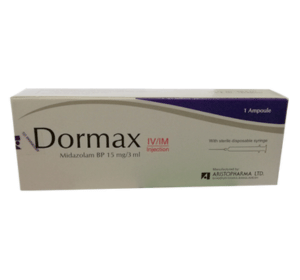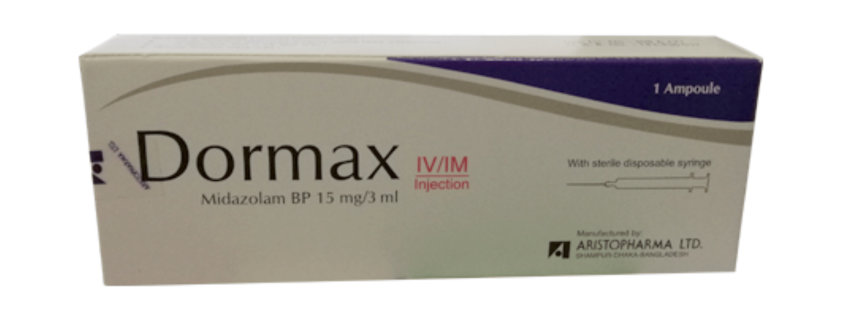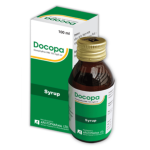Dormax (Midazolam)

Therapeutic Group : Antipsychotic, Neurotonic & Sedative
Presentation:
Dormax IV/IM Injection : Each 3 ml ampoule contains Midazolam Hydrochloride equivalent to Midazolam BP 15 mg.
Pharmacology:
Midazolam is a water-soluble benzodiazepine derivative characterized by rapid onset and short duration of action. It has anxiolytic, sedative, hypnotic and anticonvulsant characteristics as well as possible muscle relaxant characteristic.
Dosage & Administration:
Conscious/Procedural Sedation :
Adults : By slow IV injection, initially 2–2.5 mg (elderly 0.5–1 mg) at a rate of approx. 2 mg/minute 5–10 minutes before procedure, increased if necessary in steps of 1 mg (elderly 0.5–1 mg); usual total dose 3.5–5 mg (max. 7.5 mg, elderly 3.5 mg).
Children : By slow IV injection, initially 0.025-0.05 mg/kg over 2-3 minutes 5-10 minutes before procedure, increased if necessary in small step. Age wise maximum doses are as follows-
1 month–6 yrs: 6 mg; 6–12 yrs: 10 mg; 12–18 yrs: 7.5 mg.
Induction of general anesthesia :
Midazolam is used IV prior to administration of other anesthetic agents.
By slow IV injection; adult, 0.15–0.2 mg/kg (elderly or debilitated 0.05–0.15 mg/kg) given in divided doses (max. 5 mg) at intervals of 2 minutes; max. total dose 0.6 mg/kg; child 7–18 years, initially 0.15 mg/kg (max. 7.5 mg) given in steps of 0.05 mg/kg (max. 2.5 mg) over 2–5 minutes; wait for 2–5 minutes then give additional doses of 0.05 mg/kg (max. 2.5 mg) every 2 minutes if necessary; max. total dose 0.5 mg/kg (not exceeding 25 mg).
Sedation in intensive care :
Adult: By slow IV injection, initially 0.03–0.3 mg/kg given in steps of 1–2.5 mg every 2 minutes, then by slow IV injection or by continuous IV infusion, 0.03–0.2 mg/kg/hr; reduce dose (or reduce or omit initial dose) in hypovolemia, vasoconstriction, or hypothermia; lower doses may be adequate if opioid analgesic also used.
Children: Neonate under 32 wks of gestational age, by continuous IV infusion, 0.03 mg/kg/hr; neonate over 32 wks of gestational age and child under 6 months , by continuous IV infusion, 0.06 mg/kg/hr; child 6 months-12 yrs, by slow IV injection , initially 0.05–0.2 mg/kg over at least 3 minutes followed by 0.03–0.12 mg/kg/hr by continuous IV infusion; child 12-18 yrs, as recommended for adults. Doses for children should be adjusted according to response.
Sedation in general anaesthesia :
Adults: By IV injection, 0.03–0.1 mg/kg repeated as required or by continuous IV infusion, 0.03–0.1 mg /kg/hour (elderly, lower doses needed); child not recommended.
Administration :
For continuous intravenous infusion, dilute with Glucose 5% or Sodium Chloride 0.9%; for neonates and children under 15 kg body-weights, dilute to a max. concentration of 1 mg/ml.
Contrainidications:
1. Known hypersensitivity to benzodiazepines or any component of the product, 2. Respiratory insufficiency including unstable myasthenia gravis, 3. Sleep apnea syndrome, 4. Severe hepatic insufficiency. 5. Acute narrow-angle glaucoma. 6. Co-administration of any strong inhibitor of CYP3A4 isoenzyme e.g. oral ketoconazole & itraconazole
Warning & Precautions:
Treatment of insomnia with Dormax may lead to the development of physical & psychological dependence. In this case, if treatment needs to be discontinued, it should be done by tapering the dose in order to avoid withdrawal symptoms or rebound insomnia. Tapering should be tailored to individual. Sedation, amnesia, impaired concentration and impaired muscular function may adversely affect the ability to drive or to use machines specially when sleep duration is insufficient. Coma can be precipitated in patients with hepatic impairment; Caution should be taken in this case. Start with small doses in severe impairment; increased cerebral sensitivity.
Side effects:
Gastro-intestinal disturbances, jaundice, drowsiness, ataxia, amnesia, euphoria,, headache, dizziness, involuntary movements, urinary retention, incontinence, muscle weakness. Thrombophlebitis, thrombosis, local erythema, induration may arise at injection site. Some side effects are observed particularly with high doses of IV/IM injection (single dose of 10 mg or above) or on rapid injection for example, hypotension, cardiac arrest, respiratory depression & arrest.
Drug interaction:
The metabolism of Midazolam is predominantly mediated by CYP3A4 isoenzyme. That’s why concomitant administration of Midazolam is not recommended with strong inhibitor of CYP3A4 isoenzyme e.g. oral ketoconazole and itraconazole. Moderate inhibitors of CYP3A4 isoenzyme e.g. protease inhibitors, nefazodone, sertraline, grapefruit juice, fluoxetine, erythromycin, diltiazem, clarithromycin inhibit the metabolism of midazolam, leading to a prolonged action. Moderate inducers of CYP3A4 isoenzyme e.g. rifampin, rifabutin, phenytoin enhance the metabolism of Midazolam, leading to a reduced action. Sedating antidepressants, antiepileptic drugs such as phenobarbital, phenytoin and carbamazepine, sedative antihistamines, opiates, antipsychotics and alcohol enhance the sedative effects of Midazolam. It is better not to administer Midazolam with these drugs but if there is clear need of co-administration, dose of either or both of the drugs may need to be adjusted.
Use in special groups:
Use in pregnancy : Avoid regular use (risk of neonatal withdrawal symptoms); use only if clear indication such as seizure control. Like all Benzodiazepines, high doses of Midazolam during late pregnancy or labor may cause neonatal hypothermia, hypotonia & respiratory depression; use only if clear indication exists or benefit outweigh the risk.
Use in lactation : Since Midazolam passes into breast milk, Dormax should not be administered to breast-feeding mothers.
Storage:
· Store in a cool & dry place, protect from light.
· Keep out of the reach of children.
Packing:
Dormax IV/IM Injection : Each box contains 1 ampoule.



